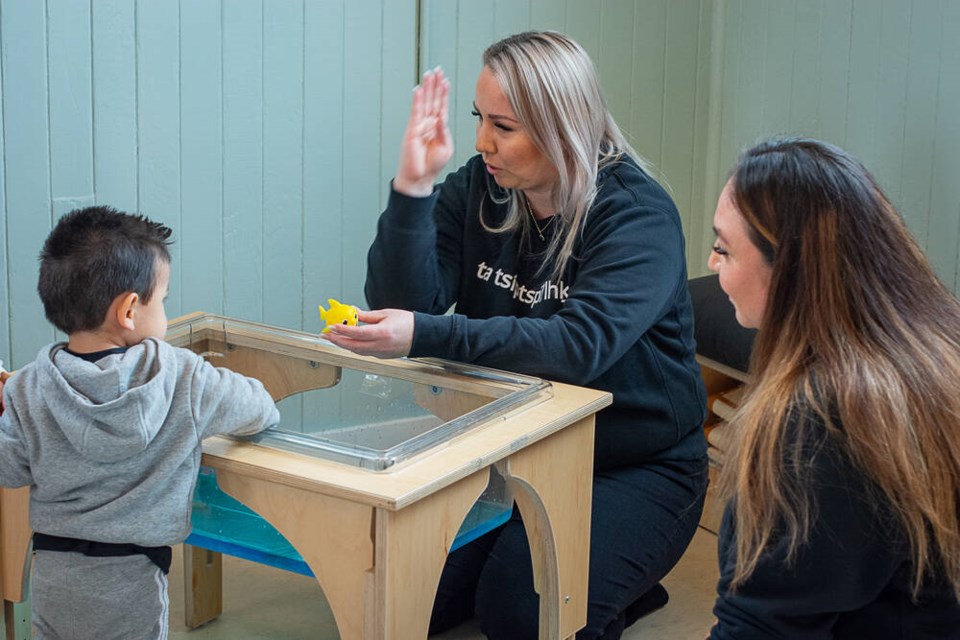The teaching of the Sḵwx̱wú7mesh Sníchim (Squamish language) has a new, bright yellow home.
After renovations wrapped up in early February, ta tsíptspi7lhḵn, which translates to “voices of the nest,” opened its doors to young learners in the Squamish Nation (Sḵwx̱wú7mesh Úxwumixw) Language Nest program.
Previously operating from a shared space in the Capilano Little Ones School, the Language Nest now has a permanent home within the walls of the Little Yellow Schoolhouse, which was transported to X̱wemelch’stn (Capilano 5 Reserve) from Kitsilano, the former Squamish village of Sen̓áḵw.
A year ago, the historic building faced demolition to make way for the new Henry Hudson Elementary, but by the Nation in the eleventh hour, and then transported by barge across Burrard Inlet to its new address near the Chief Joe Mathias Centre.
At an official opening ceremony on Friday, Language Nest teachers and representatives from the Nation honoured people who made the schoolhouse rescue and restoration possible. Snow white baby blankets were handed to Glyn Lewis, whose company Renewal Home Development led the relocation effort; to members of Vancouver School Board, which re-allocated its $80,000 demolition budget to the Nation; and to employees of Ikea, which donated more than 500 items to the project.
Currently, 12 families with 18 babies and toddlers take part in the Language Nest program, where teachers primarily speak Squamish in a home-like environment.
It’s a place where the little ones feel safe in an immersive language setting, explained head teacher Halat Kaiya Williams, one of three instructors at the school.
“We’re the ones who are following them around everywhere, kind of like commentators – so we’re talking to each other and talking to our little ones, and also to their families, just saying what they’re doing in our language,” she said.
It’s like living a dream of being at home and speaking their mother tongue in everyday life, said Cherie McFadyen, one of the other teachers.
“It would be like a regular day for a lot of our ancestors, waking up in the morning, getting ourselves ready, getting our children ready to be somewhere,” she said. “Everyday life would be an immersion that they wouldn’t need to have a dedicated space to speak to their children.”
Squamish language declared endangered in 2010, now hundreds of learners
After decades of punishment for speaking Indigenous languages in residential and day schools, many of these mother tongues were nearly wiped out. In 2010, the Squamish Nation declared their language to be “critically endangered” with just 10 fluent speakers remaining.
But following efforts which have seen classes taught in North Shore elementary and high schools, as well as local universities, the Nation reports hundreds of active language learners in the community.
Williams said she was fortunate to speak her language at home starting at a young age, then continued through school which included being part of Capilano University’s first certificate program cohort in 2008. She moved on to the Squamish language proficiency diploma at SFU and is now completing her masters in linguistics in a First Nations Language.
McFadyen’s learning journey started as an adult seven years ago, and she would go on to complete the certificate and diploma programs at SFU before starting to teach at the Language Nest program in 2019.
McFadyen said she was drawn to learning the language. “It found me. I was held responsible to learn it and to use it and teach it,” she said.
Teaching Squamish as a first language to young children has spiritual significance, Williams said.
“When we walk in through the doors of our nest, we know why we’re here, and what it’s going to take to create those first language speakers. And that dedication that our ancestors before us worked so hard for, and that we need to carry on to do the same,” she said.
First language immersion 'next step' in cultural revitilization
At Friday’s opening, Williams handed one of the white blankets to Chiyálhiya Lila Johnston, who was known as the “baby” of the Elders language advisory group.
“We just wanted to hold her up as well because we wouldn’t be here today if we didn’t have our Elders and our mentors who fought so hard to be where we are today with our language,” Williams said.
Amid the ceremony’s speeches, television cameras and neatly dressed adults, the footsteps of one-year-old Wakaystn Campbell could be heard pitter-pattering across the schoolhouse room. Wakaystn started coming to the Nest last year.
Occasionally, the clamour would pause as Williams and McFadyen would lead Wakaystn through songs, which included Squamish renditions of Roly Poly and Head, Shoulders, Knees and Toes.
Wakaystn’s father, Xalek/Sekyu Siyam Ian Campbell, said it’s amazing to see how the program has helped to build his son’s vocabulary and understanding of the language.
“We speak a lot of the language at home,” he said. “We’re noticing week by week, his vocabulary is expanding – six new words last week, for example. That was amazing.”
Having programs in nearby elementary and high schools has helped create a foundation of language learners, but the Language Nest program has taken it to the next step, Campbell said.
“To actually have immersion here in our community, along with a path to the (Capilano) Little Ones School where they’re fully utilizing language on a daily basis, we’re seeing a really strong upbringing … of our teachings and our values embedded in the language, which is super exciting to see: a brighter future as a result of language and cultural revitalization,” he said.





